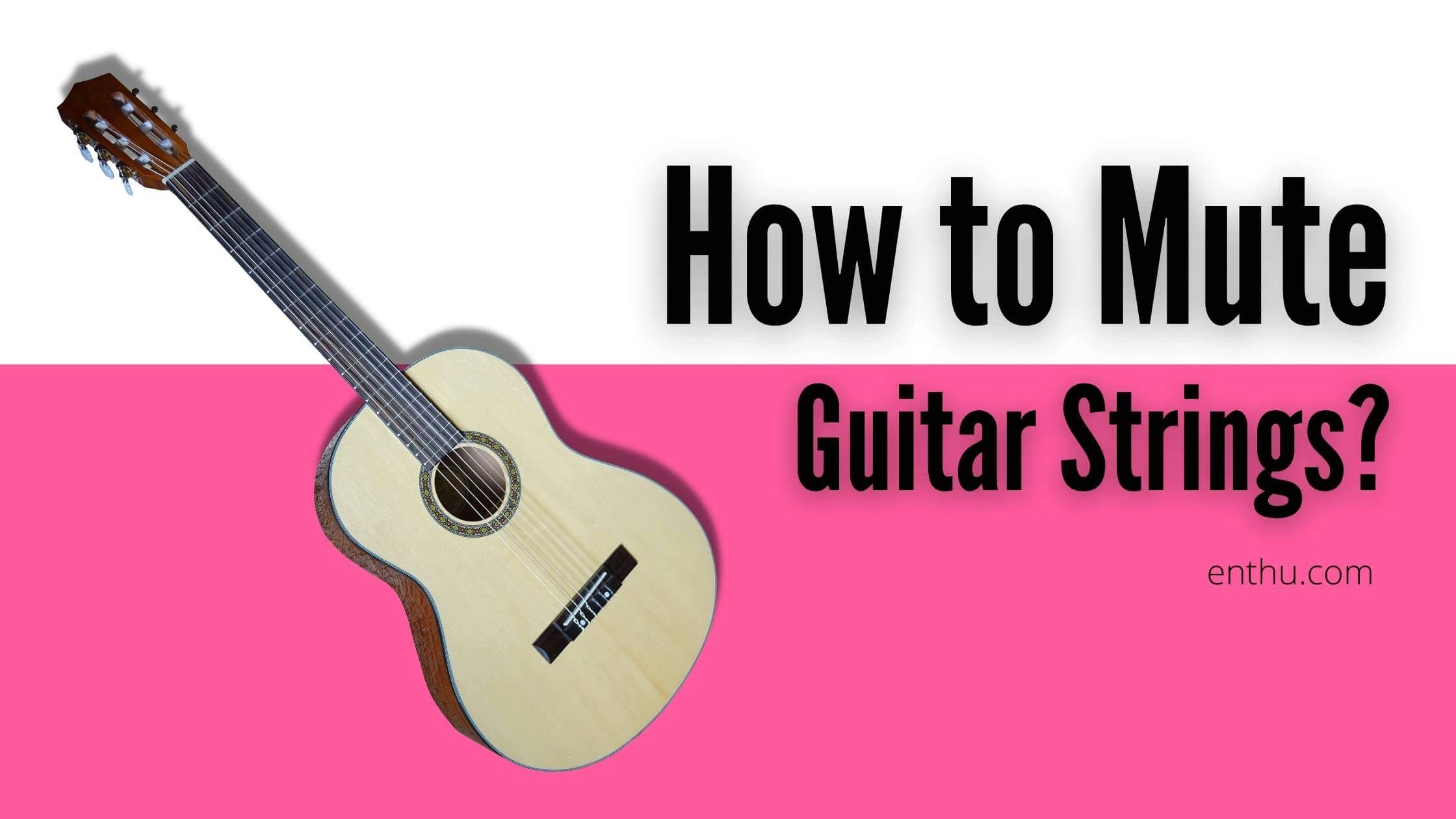Imagine driving a car and not knowing how to brake; it won't be a good experience. Such is the importance of muting guitar strings. It is itself hard to strike the right note on a string, but have you ever thought of muting one for purpose?
Well, it is easier than you think. And believe me or not, learning how to mute guitar strings can help you create an edgy effect on your music. So, let's bring your guitar skills to the next level by learning and implementing the muting techniques.
- How to Mute Guitar Strings
- Why Should You Mute Your Guitar Strings
- Conclusion
- FAQs
- 1. What does it mean to mute guitar strings?
- 2. Why is it important to mute guitar strings?
- 3. What are the methods to mute guitar strings?
- 4. Can muting string technique change the tone of my guitar?
- 5. Is it necessary to mute strings for all guitar playing styles?
- 6. How can I practice muting guitar strings effectively?
- 7. Are there any tools that can help with muting guitar strings?
- 8. Can beginners learn to mute guitar strings easily?
- 9. How long does it take to master muting techniques on the guitar?
- 10. Where can I find resources to learn more about muting techniques?
How to Mute Guitar Strings

1. Fretting Hand Lift Method
This is the simplest way to mute your guitar strings and stop unwanted sounds. All you have to do is pick up your fretting hand finger (in this case, left hand). When you play a note on the guitar, it takes two fingers to play the note properly.

If you release one of the fingers, it will release the tension of the string. However, most beginners often make the mistake of lifting their fretting fingers abruptly. Rather than muting the string, it creates musical jargon and sometimes creates unwanted sound.

Practice this method by stopping pressing the string when you feel like muting it. Although, if you release your finger/fingers slowly, it will create a buzzing sound, so it is best to stop the pressure quickly or to blend this method with the next one.
2. Fretting Hand Touch Method
Have you seen a guitarist abruptly touching the string while playing or at the end of it? Well, it's because they were trying to mute the string for the composition and stop unwanted noise. This is yet another effective method for muting your guitar instantly.
All you have to do is touch the particular string with any finger of your fretting hand. If you are playing a chord, then you can use the whole hand. Be careful while using this method because if you press the string/s hard, they might just create a new sound.

Doing it properly requires a lot of practice and precision. Both the hand touch and hand lift methods work well in country music and rock-and-roll music.
Join EnthuZiastic Guitar Classes today for an immersive learning experience
3. The Plant Method
If you have ever watched Joe Satriani live or at least seen him playing the guitar on YouTube, you may have seen him use the plant method. This method is heavily used for folk and pop music.
'Planting' method is a way to prepare your strumming hand for blocking the strings instantly after playing them. This method gives you accurate timing and confidence for playing the strings and gives an abrupt and edgy tone while muting a string.
The trick is to keep your strumming hand ready on the saddle to quickly touch the strings with your finger to mute them.
4. Right Hand Thumb Muting Technique
Using the right-hand thumb (or actually the thumb of the plucking hand) is a popular technique of muting strings. It is especially useful when you are playing high-tempo compositions.
As thumbs are used for chord plucking, sometimes you can both mute a string and play the next note all along. However, you must remember to use the side of your thumb for sharp plucking. You can combine the 'Plant' method and the right-hand thumb muting technique both together.
5. Karate Chop Technique
Yeah, you've read it right. You have probably applied it to your opponent; now, you have to do it on your guitar strings, although gently. This method uses the outer edge of your right hand (your picking hand) to stop the vibration of the strings.
The hand gesture is similar to karate chops, hence the name. If you play classical or Spanish guitar, be extra careful while using the karate chop technique, as a little extra pressure can also create unprecedented sound. This method gives a dramatic closure to electric and classical guitar pieces.

6. The Fading Technique
While Karate chop might seem a bit abrupt, the Fading technique is the ideal guitar string muting technique for a fade-out effect.
You need to roll your hands around the bridge and stretch out your right arm forward. Your hand will tune down the volume regulator to give it an edgy finishing touch. This method is very simple, yet it is a bit difficult to ace the smooth motion.
7. Pizzicato Muting Technique
The name itself is interesting. Pizzicato or 'muted bass' technique involves strumming or plucking with the thumb and keeping the side of the hand rested gently on the strings near the bridge.
This method is similar to the palm muting technique of bass and electric guitar. The pizzicato technique reduces the sustainability of the strings and offers a sound effect like a bass guitar - low in pitch and without sustain.
The above-mentioned Fading technique is a perfect blend with this muting method. Here's another amazing video tutorial for muting guitar strings:
Why Should You Mute Your Guitar Strings
You have learned a few guitar muting techniques, but have you wondered why you should do this? Beginners, sometimes even seasoned players, make the mistake of accidentally playing open strings while playing a scale. This can completely ruin the impact of the scale and, obviously, the sound.
For this reason, muting guitar strings consciously is a healthy and safe practice to play the scales and complex compositions without ruining the sound effect. This is the main reason to mute a string.
The best thing is that it doesn't take much time and also is very easy to articulate on the guitar. Secondly, muting is also used as a tool for creating interesting soundscapes. Sometimes, guitarists purposefully use muting techniques to create muted tones.
Most of the Grunge bands in the 1990s heavily used string muting techniques to bring freshness and a new soundscape to their music. |
1. How Do You Stop Muting Nearby Strings
We have muted out strings even before we learned how to mute guitar strings, which is a problem. It is essential to learn the techniques at the beginning of your guitar learning journey to stop your fingers from muting the strings unnecessarily.
Tips to stop muting nearby strings
First of all, sit in the right posture. Your posture plays a huge role in your performance.
Work on your thumb position of the fretting hand. Keep your thumb pointing upwards. It should reach the angular top of the neck.
Don't keep the neck of the guitar close to your body. Always keep space between your fretting hand and the guitar neck.
Pluck or strum the strings near the bridge of the guitar.
2. How Do You End a Note
Just like composition or a story, a simple note also has a beginning, a middle, and an end. Most guitar players focus so much on the beginning and middle part in their initial years of learning that they forget how to end a note. When we fret a string and pluck it, the initial loud sound is the beginning and the lingering effect (fretted or open) of the tone in the middle.

Lastly, when we forcefully stop a note or naturally fade out, it is called the end of the note. Each note we play has three parts: the beginning, the middle, and the end. How you end a note is as important as fretting and plucking a string. So, your goal should be to learn how to play interconnected notes with the proper ending for each one.
The same thing is applicable for chords, scales, and chord progressions as well. If you don't know when to stop or end the note, you can never play a composition properly. Every chord you play has the same beginning, middle, and end structure.

So, you should use the legato effect while playing the chords. Although sometimes, you will need to cut the duration short of the note, chord, or scale, I would suggest you use these muting techniques for a smooth transition in your music.


Conclusion
Now that you have learned how to mute guitar strings, there's no going back. All you need to do is sit back, relax, and practice what you've learned. I can assure you that it will open up a new horizon for your guitar-playing experience. Start playing, mute when needed, and create amazing tunes that we can't forget. Best wishes for your musical journey ahead!
FAQs
1. What does it mean to mute guitar strings?
Muting guitar strings refers to the technique of dampening or silencing the strings to prevent unwanted sounds or noise while playing. This allows guitarists to achieve clean tones and enhances the overall sound quality of their performance.
2. Why is it important to mute guitar strings?
Muting is essential for playing cleanly and efficiently, particularly in styles like rock, funk, and jazz. It helps eliminate unwanted string noise, enhances articulation, and allows for more precise playing, making your overall performance more professional.
3. What are the methods to mute guitar strings?
Here are some common methods to mute guitar strings:
Palm Muting: Place the edge of your picking hand (palm) lightly on the strings near the bridge while strumming or picking.
Finger Muting: Use your fingers on your fretting hand to lightly touch and dampen the strings you are not currently playing.
Thumb Over the Neck: If you’re playing a fretted note, use your thumb to lightly touch the strings above the fretboard.
Mute with the Pick: Adjust your picking technique to include a muting motion with your pick to silence strings that you don’t want to resonate.
4. Can muting string technique change the tone of my guitar?
Yes, muting techniques can significantly alter your tone. For example, palm muting creates a more muted, soft sound, while finger or thumb muting can add clarity and reduce unwanted resonance, allowing for greater control over your guitar’s tonal quality.
5. Is it necessary to mute strings for all guitar playing styles?
While it is not required for every style, muting is particularly beneficial in styles that involve complex chord progressions and fast melodic lines. It ensures that your intended notes stand out clearly without interference from adjacent strings.
6. How can I practice muting guitar strings effectively?
To practice muting effectively:
Isolate techniques: Focus on one muting technique at a time.
Use a metronome: Play along with a metronome to maintain rhythm while practicing.
Slow Practice: Start slowly to ensure you're applying the right amount of pressure without losing the intended sound.
Incorporate into songs: Integrate muting techniques into your favorite songs to see how they enhance your playing.
7. Are there any tools that can help with muting guitar strings?
While the primary muting techniques rely on hand positioning and technique, some guitar accessories, like string dampeners or fret wraps, can assist in minimizing unwanted noise when not playing. However, developing proper muting techniques on your own is the best approach.
8. Can beginners learn to mute guitar strings easily?
Absolutely! With a little practice, beginners can quickly learn how to mute guitar strings. Starting with simple techniques like palm muting and finger muting can enhance their playing skills and help them develop a cleaner sound early on in their learning journey.
9. How long does it take to master muting techniques on the guitar?
The time it takes to master muting techniques varies for each guitarist. With consistent practice, noticeable improvement can occur within a few weeks. However, achieving a high level of proficiency may take several months or longer, depending on one's practice routine and dedication.
10. Where can I find resources to learn more about muting techniques?
There are plenty of resources available for guitar enthusiasts, including:
Guitar tutorials on YouTube: Many instructors offer videos specifically focusing on muting techniques.
Online courses: Websites such as Udemy or GuitarLessons.com provide structured lessons.
Books: Consider instructional books that cover guitar techniques, including muting.
Guitar forums and communities: Engaging with fellow guitarists can provide tips and additional resources.






Comments